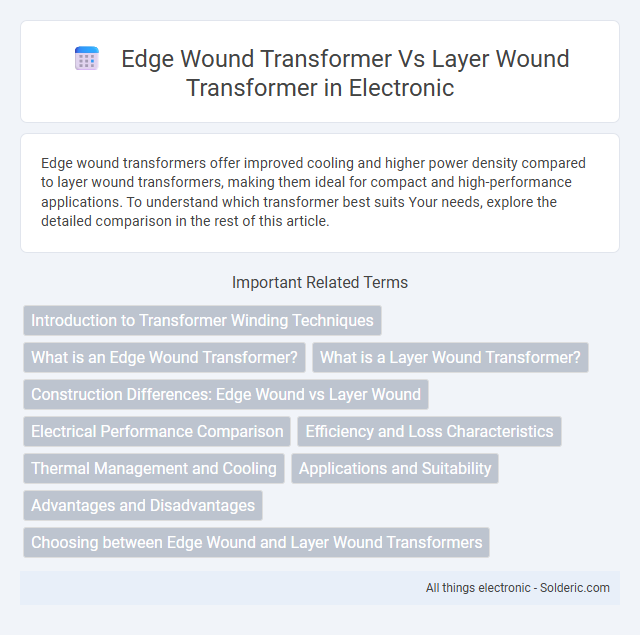Edge wound transformers offer improved cooling and higher power density compared to layer wound transformers, making them ideal for compact and high-performance applications. To understand which transformer best suits Your needs, explore the detailed comparison in the rest of this article.
Comparison Table
| Feature | Edge Wound Transformer | Layer Wound Transformer |
|---|---|---|
| Winding Technique | Thin conductor wound edgewise on bobbin | Wire wound in multiple layers |
| Size & Space Efficiency | Compact, saves space | Usually larger due to multiple layers |
| Voltage Handling | Limited to lower voltages | Suited for high voltage applications |
| Heat Dissipation | Better cooling, less heat buildup | Heat tends to accumulate in inner layers |
| Manufacturing Complexity | More complex winding process | Relatively simpler winding method |
| Applications | Audio transformers, low power circuits | Power transformers, high voltage circuits |
| Cost | Generally higher due to complex winding | Lower cost manufacturing |
Introduction to Transformer Winding Techniques
Edge wound transformers feature windings that are layered along the edge of the core, optimizing space and improving cooling efficiency through enhanced air circulation. Layer wound transformers consist of windings arranged in multiple layers atop one another, providing better voltage handling and insulation strength for high-voltage applications. These distinct winding techniques impact transformer performance, thermal management, and application suitability in electrical power systems.
What is an Edge Wound Transformer?
An Edge Wound Transformer features windings created by wrapping a thin strip of conductor edge-on around a core, optimizing magnetic flux linkage and reducing leakage inductance. This design enhances coupling efficiency and thermal dissipation compared to the traditional Layer Wound Transformer, where windings are arranged in layers on the core. Edge winding is particularly beneficial in applications requiring compact size, high-frequency operation, and minimized parasitic effects.
What is a Layer Wound Transformer?
A layer wound transformer is a type of transformer where the wire coils are arranged in successive layers, each insulated from the other to enhance electrical isolation and thermal dissipation. This winding method ensures uniform distribution of the magnetic field and improves voltage regulation, making it suitable for applications requiring stable voltage output. Compared to edge wound transformers, layer wound transformers typically offer better insulation and reduced leakage inductance, resulting in higher efficiency.
Construction Differences: Edge Wound vs Layer Wound
Edge wound transformers feature conductors wound with the narrow edge of the strip facing outward, allowing for tighter turns and better mechanical strength, which reduces leakage inductance and enhances efficiency. Layer wound transformers involve winding conductors in broad layers, producing uniform insulation but resulting in larger coil size and increased capacitance between layers. The distinct construction impacts electrical performance, thermal management, and suitability for high-frequency applications.
Electrical Performance Comparison
Edge wound transformers demonstrate superior high-frequency performance due to reduced leakage inductance and lower parasitic capacitance compared to layer wound transformers, which tend to have higher stray losses. The compact coil structure of edge wound transformers enhances magnetic coupling and minimizes eddy current losses, improving efficiency and voltage regulation. Layer wound transformers, while easier to manufacture for high-voltage applications, often exhibit increased AC resistance and thermal dissipation challenges, limiting their effectiveness in high-frequency or precision applications.
Efficiency and Loss Characteristics
Edge wound transformers typically exhibit higher efficiency due to reduced leakage inductance and better flux distribution, minimizing core losses compared to layer wound transformers. Layer wound transformers often experience increased dielectric losses and higher eddy current losses because of the multiple insulated layers, which can trap flux and cause uneven heating. The construction of edge wound transformers enhances thermal dissipation, resulting in lower copper losses and improved overall performance in high-frequency applications.
Thermal Management and Cooling
Edge wound transformers offer improved thermal management due to their compact coil design, which facilitates better heat dissipation and reduced thermal impedance. Layer wound transformers tend to generate higher thermal hotspots within the coil layers, requiring more extensive cooling mechanisms such as oil or forced air circulation. Effective cooling in edge wound transformers enhances efficiency and prolongs insulation life compared to traditional layer wound counterparts.
Applications and Suitability
Edge wound transformers excel in high-frequency applications such as RF circuits and induction heating due to their low leakage inductance and compact design. Layer wound transformers are better suited for power distribution and audio-frequency applications where higher voltage ratings and better insulation are required. Selection depends on operating frequency, voltage levels, and space constraints to ensure optimal performance and reliability.
Advantages and Disadvantages
Edge wound transformers offer advantages such as lower leakage inductance and better high-frequency performance due to their winding technique, making them suitable for compact, high-efficiency applications. Layer wound transformers, in contrast, provide simpler construction and better voltage insulation between layers but tend to have higher leakage inductance and less efficiency at high frequencies. When selecting a transformer, your choice depends on balancing the need for compactness and efficiency against insulation requirements and ease of manufacturing.
Choosing between Edge Wound and Layer Wound Transformers
Choosing between edge wound and layer wound transformers depends on application-specific voltage, current, and frequency requirements. Edge wound transformers are ideal for high-voltage, low-current scenarios due to their efficient insulation and minimal capacitance, while layer wound transformers excel in handling higher currents with lower leakage inductance. Understanding these characteristics ensures optimal transformer performance and reliability in electrical systems.
edge wound transformer vs layer wound transformer Infographic

 solderic.com
solderic.com